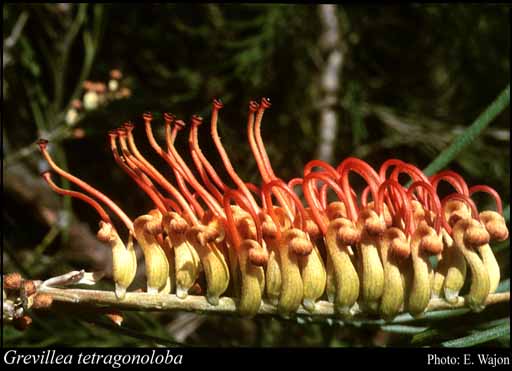- Reference
- A.DC., Prodr. 14:374 (1856)
- Conservation Code
- Not threatened
- Naturalised Status
- Native to Western Australia
- Name Status
- Current
Erect to spreading shrub, 0.6-2.6 m high. Fl. red & brown, Jun to Nov. Sand or loam, sometimes with gravel, on laterite, granite or quartzite.

Scientific Description
Shrubs, 1-2.5 m high; branchlets hairy, not glaucous. Leaves alternate, 60-130 mm long, hairy, on the abaxial surface, the hairs straight; lamina flat, once divided, pinnately divided, divided to the midrib; lobes 30-75 mm long, 1-1.5 mm wide, the margins revolute, enclosing the lower surface of the leaf blade, forming a groove either side of the midvein. Inflorescences terminal, brown; pedicels 1-2 mm long. Perianth 8-10 mm long; tepals all free after flower opens, hairy, simple-hairy; ovary hairy, sessile; pistil 20-25 mm long, orange or red, pollen presenter oblique, style glabrous. Follicles hairy, not viscid, dehiscent, 10-15 mm long. Flowers in June, July, August, September, October or November. Occurs in the South-west (SW) Botanical Province(s), in the Mallee (MAL) or Esperance Plains (ESP) IBRA subregion(s).
Distribution
- IBRA Regions
- Esperance Plains, Jarrah Forest, Mallee.
- IBRA Subregions
- Fitzgerald, Southern Jarrah Forest, Western Mallee.
- Local Government Areas (LGAs)
- Albany, Gnowangerup, Jerramungup, Lake Grace, Plantagenet, Ravensthorpe.